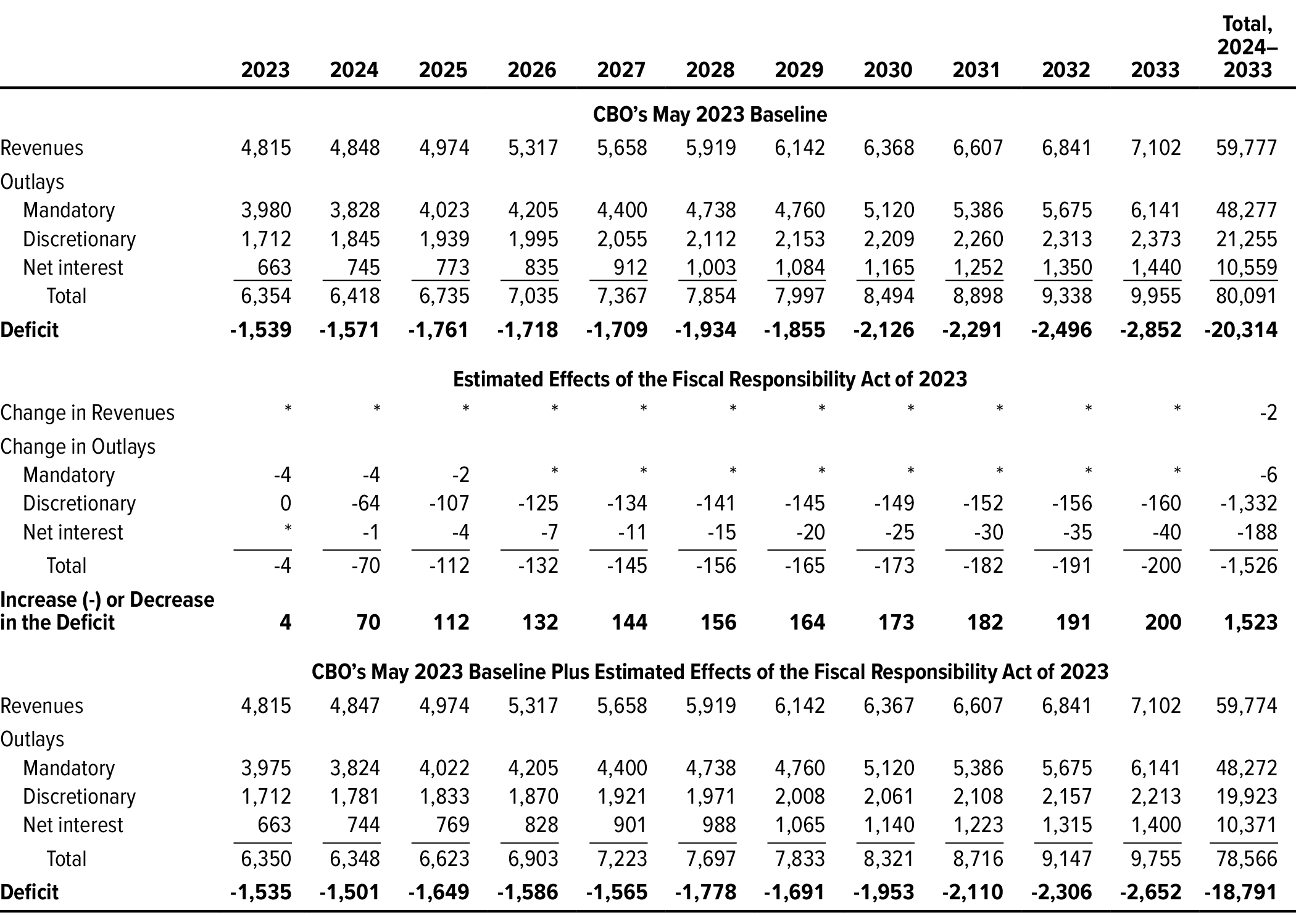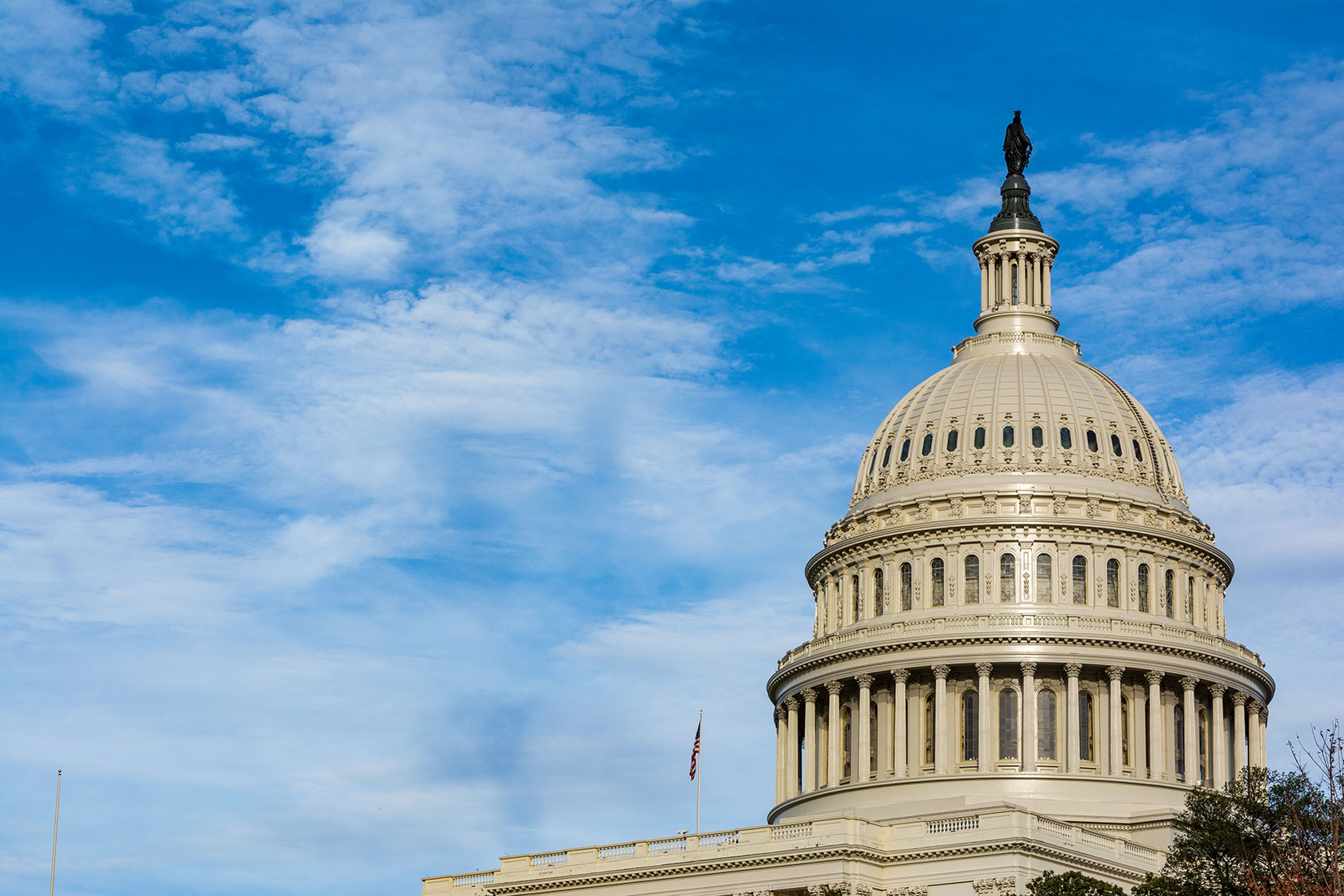Notes
Unless this report indicates otherwise, all years referred to are federal fiscal years, which run from October 1 to September 30 and are designated by the calendar year in which they end. Numbers in the text and tables may not add up to totals because of rounding.
On June 3, President Biden signed into law the Fiscal Responsibility Act of 2023 (FRA, Public Law 118-5), which suspends the limit on federal debt through January 1, 2025, and makes a number of changes that affect federal spending and revenues. The Congressional Budget Office provided an assessment of the budgetary effects of that act in a letter dated May 30.1
This report builds on that earlier assessment by showing how those budgetary effects change projections of federal debt.2 Specifically, the $1.5 trillion reduction in projected deficits estimated to result from the FRA over the next 10 years reduces projected federal debt held by the public in 2033 by about 3 percent, from $46.7 trillion (or 119 percent of gross domestic product, or GDP) to $45.2 trillion (or 115 percent of GDP).
Key Budgetary Provisions in the Law
In addition to suspending the debt limit, the law includes many other provisions that affect spending and revenues, including provisions that do the following:
- Impose caps on most discretionary funding (that is, funding that is subject to the appropriation process) for 2024 and 2025,
- Rescind certain unobligated funds provided in response to the coronavirus pandemic,
- Modify work requirements for recipients of Supplemental Nutrition Assistance Program benefits and Temporary Assistance for Needy Families, and
- Rescind certain funds provided to the Internal Revenue Service.
The Law’s Effect on Projections of Budget Deficits
In its May 30 letter, CBO reported that the Fiscal Responsibility Act would reduce its projections of budget deficits by about $1.5 trillion over the 2024–2033 period relative to the baseline budget projections that CBO published on May 12, 2023.3 Most of that reduction in deficits stems from the assumption that the statutory caps in the FRA will limit discretionary funding in 2024 and 2025.4 Not only will those caps affect spending in 2024 and 2025, but they also affect CBO’s projections of discretionary spending in 2026 and beyond because of the way that the agency is required to project funding in those years. In CBO’s projections, discretionary funding in a future year generally is based on the amount of funding provided or projected for the previous year, adjusted for inflation. Because the caps reduce projected funding for fiscal year 2025, the projections for the following year (and each year thereafter) are also reduced.
In CBO’s May 2023 budget baseline, annual deficits increase from $1.5 trillion in 2023 to $2.9 trillion in 2033, and the cumulative deficit for the 2024–2033 period totals $20.3 trillion (see Table 1, top panel). Subtracting the estimated effect of the FRA on projected deficits from those baseline projections reduces the projected deficit in 2033 to $2.7 trillion and the cumulative deficit for the 2024–2033 period to $18.8 trillion (see Table 1, bottom panel).
Table 1.
Projections in CBO’s May 2023 Baseline and Estimated Effects of the Fiscal Responsibility Act of 2023
Billions of Dollars

Data source: Congressional Budget Office. See www.cbo.gov/publication/59235#data.
* = between -$500 million and zero.
The Law’s Effect on Projections of Federal Debt
The smaller deficits projected under the FRA reduce CBO’s projections of federal debt. In CBO’s May 2023 baseline projections, debt held by the public in 2033 is $46.7 trillion, or 119 percent of GDP (see Table 2).5 Subtracting the $1.5 trillion reduction in projected deficits estimated to occur under the FRA from those baseline amounts results in debt held by the public in 2033 of $45.2 trillion, or 115 percent of GDP, a roughly 3 percent reduction.
Table 2.
Estimated Effects of the Fiscal Responsibility Act of 2023 on Debt in CBO’s May 2023 Baseline

Data source: Congressional Budget Office. See www.cbo.gov/publication/59235#data.
FRA = Fiscal Responsibility Act of 2023 (H.R. 3746, enacted on June 3, 2023, as Public Law 118-5); n.a. = not applicable; * = between -0.05 percent of gross domestic product and zero.
The smaller projected deficits also result in a decrease of $1.5 trillion in 2033 in CBO’s projections of debt subject to the statutory limit, which includes debt held by the public along with Treasury securities held by federal trust funds and other government accounts. In CBO’s May baseline projections, debt subject to that limit reaches $52.4 trillion in 2033. After subtracting the estimated effects of the FRA, that measure of debt is $50.9 trillion.
1. Congressional Budget Office, letter to the Honorable Kevin McCarthy providing CBO’s estimate of the budgetary effects of H.R. 3746, the Fiscal Responsibility Act of 2023 (May 30, 2023), www.cbo.gov/publication/59225.
2. The projections presented in this report do not constitute a new release of CBO’s baseline budget projections, the most recent of which were published in Congressional Budget Office, An Update to the Budget Outlook: 2023 to 2033 (May 2023), www.cbo.gov/publication/59096. CBO’s budget baseline is a set of projections of revenues, spending, deficits, and debt indicating what the federal budget would look like in the current year and over the next 10 years if existing laws governing taxes and spending generally remained unchanged. Preparing new baseline projections would involve a more comprehensive assessment of the budget outlook.
3. CBO has not undertaken a dynamic analysis of P.L. 118-5; such an analysis would account for the budgetary effects of resulting changes in the total output of the economy and in other key economic variables. Other legislation enacted between March 30, 2023 (when CBO finalized the baseline projections that it published in May), and June 3, 2023 (when the FRA was enacted), did not have significant budgetary effects.
4. P.L. 118-5 also establishes annual funding limits from 2026 through 2029 that can be enforced using the Congress’s procedures for considering budgetary legislation. The effects of those limits are not included in this analysis.
5. Federal debt held by the public consists mostly of securities that the Treasury issues to raise cash to fund the federal government’s activities and to pay off its maturing liabilities.
This report was prepared in response to interest from the Congress. In keeping with the Congressional Budget Office’s mandate to provide objective, impartial analysis, the report makes no recommendations.
Avi Lerner prepared the report with guidance from Christina Hawley Anthony and Chad Chirico and with contributions from Leigh Angres, Megan Carroll, John McClelland, and Sam Papenfuss. Mark Doms, Mark Hadley, Jeffrey Kling, and Robert Sunshine reviewed the report. Lora Engdahl and Bo Peery edited it, and Casey Labrack prepared it for publication. The report is available at www.cbo.gov/publication/59235.
CBO seeks feedback to make its work as useful as possible. Please send comments to communications@cbo.gov.

Phillip L. Swagel
Director


